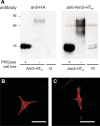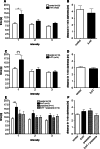Characterization of the 5-HT1A receptor of the honeybee (Apis mellifera) and involvement of serotonin in phototactic behavior
- PMID: 20349263
- PMCID: PMC11115497
- DOI: 10.1007/s00018-010-0350-6
Characterization of the 5-HT1A receptor of the honeybee (Apis mellifera) and involvement of serotonin in phototactic behavior
Abstract
Serotonin plays a key role in modulating various physiological and behavioral processes in both protostomes and deuterostomes. The vast majority of serotonin receptors belong to the superfamily of G-protein-coupled receptors. We report the cloning of a cDNA from the honeybee (Am5-ht1A) sharing high similarity with members of the 5-HT(1) receptor class. Activation of Am5-HT(1A) by serotonin inhibited the production of cAMP in a dose-dependent manner (EC(50) = 16.9 nM). Am5-HT(1A) was highly expressed in brain regions known to be involved in visual information processing. Using in vivo pharmacology, we could demonstrate that Am5-HT(1A) receptor ligands had a strong impact on the phototactic behavior of individual bees. The data presented here mark the first comprehensive study-from gene to behavior-of a 5-HT(1A) receptor in the honeybee, paving the way for the eventual elucidation of additional roles of this receptor subtype in the physiology and behavior of this social insect.
Figures









Similar articles
-
Distribution of serotonin (5-HT) and its receptors in the insect brain with focus on the mushroom bodies: lessons from Drosophila melanogaster and Apis mellifera.Arthropod Struct Dev. 2011 Sep;40(5):381-94. doi: 10.1016/j.asd.2011.01.004. Epub 2011 Jan 25. Arthropod Struct Dev. 2011. PMID: 21272662 Review.
-
Am5-HT7: molecular and pharmacological characterization of the first serotonin receptor of the honeybee (Apis mellifera).J Neurochem. 2006 Sep;98(6):1985-98. doi: 10.1111/j.1471-4159.2006.04012.x. J Neurochem. 2006. PMID: 16945110
-
Function and distribution of 5-HT2 receptors in the honeybee (Apis mellifera).PLoS One. 2013 Dec 6;8(12):e82407. doi: 10.1371/journal.pone.0082407. eCollection 2013. PLoS One. 2013. PMID: 24324783 Free PMC article.
-
Larvae of the small white butterfly, Pieris rapae, express a novel serotonin receptor.J Neurochem. 2014 Dec;131(6):767-77. doi: 10.1111/jnc.12940. Epub 2014 Sep 23. J Neurochem. 2014. PMID: 25187179
-
5-HT1A and 5-HT1B receptor agonists and aggression: a pharmacological challenge of the serotonin deficiency hypothesis.Eur J Pharmacol. 2005 Dec 5;526(1-3):125-39. doi: 10.1016/j.ejphar.2005.09.065. Epub 2005 Nov 28. Eur J Pharmacol. 2005. PMID: 16310183 Review.
Cited by
-
Age-dependent transcriptional and epigenomic responses to light exposure in the honey bee brain.FEBS Open Bio. 2016 Jun 13;6(7):622-39. doi: 10.1002/2211-5463.12084. eCollection 2016 Jul. FEBS Open Bio. 2016. PMID: 27398303 Free PMC article.
-
Modulatory actions of dopamine and serotonin on insect antennal lobe neurons: insights from studies in vitro.J Mol Histol. 2012 Aug;43(4):401-4. doi: 10.1007/s10735-012-9401-7. Epub 2012 Mar 21. J Mol Histol. 2012. PMID: 22430182 Review.
-
Serotonergic modulation across sensory modalities.J Neurophysiol. 2020 Jun 1;123(6):2406-2425. doi: 10.1152/jn.00034.2020. Epub 2020 May 13. J Neurophysiol. 2020. PMID: 32401124 Free PMC article. Review.
-
Parallel reinforcement pathways for conditioned food aversions in the honeybee.Curr Biol. 2010 Dec 21;20(24):2234-40. doi: 10.1016/j.cub.2010.11.040. Epub 2010 Dec 2. Curr Biol. 2010. PMID: 21129969 Free PMC article.
-
Cognitive components of color vision in honey bees: how conditioning variables modulate color learning and discrimination.J Comp Physiol A Neuroethol Sens Neural Behav Physiol. 2014 Jun;200(6):449-61. doi: 10.1007/s00359-014-0909-z. Epub 2014 May 1. J Comp Physiol A Neuroethol Sens Neural Behav Physiol. 2014. PMID: 24788332 Review.
References
Publication types
MeSH terms
Substances
LinkOut - more resources
Full Text Sources

